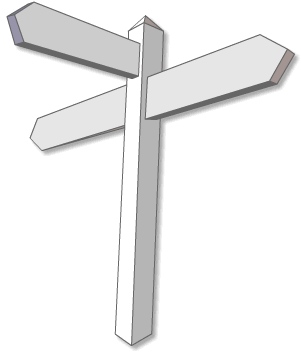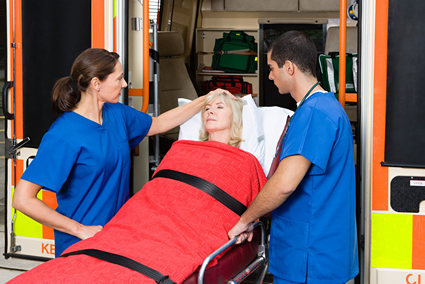- Visual problems can be easily missed but may have significant impact on long term quality of life
- Although visual problems may be a long term consequence of stroke there are effective strategies which can help
- Assessment by trained professionals and access to support and reassurance are essential
- There are many services and organisations which can help people with visual problems after stroke
- Regular vision testing is important for everyone
Click here to proceed to conclusion
 Peter is now more confident in his reading abilities having incorporated several strategies to help him to do so.
Peter is now more confident in his reading abilities having incorporated several strategies to help him to do so.
He is able to read short stories with Sean and now encourages him to do some of the reading. Peter will have his vision reassessed in 6 months time.
‘Thrombolysis’ means the breaking up of blood clots. Thrombolysis or ‘clot-busting’ medicine called tissue plasminogen activator (tPA) can dissolve the blood clot causing acute ischaemic stroke, which is the commonest type of stroke (85% of strokes). The two common thrombolysis drugs are alteplase (an intravenous bolus followed by an infusion over one hour) and Tenecteplase (just a bolus). Thrombolysis is not appropriate if the stroke has been caused by a haemorrhage (15% of strokes). Thrombolysis treatment increases the chances of a fuller recovery; however it is not effective in every case. Treatment can potentially cause bleeding, which may be serious but frequently this is minor and is often not significant.
Thrombolysis treatment can dissolve the blood clot and open the artery.

There are other agencies that can offer support after the patient is discharged from hospital. These include:
- Local and national visual impairment organisations
- Local and national stroke support organisations
- Local authority/social work sensory impairment services
- Vocational rehabilitation services
Contacts:
Local societies for the blind in Scotland who work specifically with people affected by sight loss after stroke:
The ophthalmologist or the orthoptist will discuss a patient’s eye condition and any treatment that is relevant, and may ask the patient to return for further treatment or examination. If they consider the eye condition to be causing a significant visual impairment that is not likely to be helped by treatment or by a new spectacle prescription they may suggest registration as blind or partially sighted. This option should be agreed between the patient and ophthalmologist.
Facts about becoming registered as blind or partially sighted [PDF]
On completion of the module the learner will have a critical understanding of:
- The purpose, evidence-base, benefits and risks of thrombolysis and/or thrombectomy treatment following stroke
- The importance of ‘Time is Brain’ in relation to these treatments, and why stroke should be treated as a medical emergency
- The criteria for use, and the potential contra-indications, of thrombolysis and thrombectomy treatments following stroke; see Word .doc Eligibility for thrombectomy
- Providing information and support to the patient and their family about these treatments
- The properties, actions, dosages, administration and side-effects of thrombolysis
- The details of thrombectomy which are relevant to those caring for patients with hyperacute stroke
- Nursing observation, monitoring, care and interpretation of the patient’s condition before, during and after thrombolysis and thrombectomy treatment, responding appropriately to changes or deterioration
- Causes, manifestations and management of adverse reactions following thrombolysis treatment
- How the patients progress through the hyperacute treatment pathways can be as rapid and smooth as possible
This module aims to provide an overview of hyperacute treatments including thrombolysis and thrombectomy following ischaemic stroke; and to ‘demystify’ these treatments to improve understanding.
The content comprises five patient scenarios; within the scenarios the patient may or may not turn out to be suitable for thrombolysis and/or thrombectomy treatment. Only 15-20% of patients following stroke are suitable for thrombolysis and/or thrombectomy.

The orthoptist initiates treatment for Peter’s visual problems and discusses the findings of the visual assessment with the occupational therapist who then continues his rehabilitation.
There are two categories of interventions which might be used to manage saccadic eye movement problems:
- Substitution interventions which aim to improve the actual saccadic eye movements
- Compensatory interventions which reduce the impact of saccadic eye movement problems by providing a different or alternative way of performing the specific task

Module Authors
This module has been developed by:
Prof Martin Dennis, Professor of Stroke Medicine, The University of Edinburgh
Jacqueline Aim, e-learning Content Developer, Interactive Content, The University of Edinburgh
Videos were provided by:
Mark Garside – Northumbria Healthcare
Chris Price – Newcastle University
Scans were provided by:
Prof Andrew Farrall, Edinburgh Imaging Academy, University of Edinburgh
Dr Grant Mair, University of Edinburgh
The following individuals reviewed the content and provided feedback:
Amanda Johnson, Stroke trainer, CHSS
Amy Matheson, Scottish Ambulance Service
Dr Matthew Lambert, NHS Tayside
Dr Richard O’Brien, NHS Lothian
Dr Mark Garside, Northumbria Healthcare
Dr Vera Cvoro, NHS Fife
Dr Christine McAlpine, Glasgow Royal Infirmary
This module aims to provide an overview of hyperacute treatments including thrombolysis and/or thrombectomy after acute stroke. It is relevant to any healthcare professional involved in any part of the patient’s pathway.
The introduction of thrombolysis and thrombectomy has greatly increased the importance of teamwork. Whilst only part of the content may be directly relevant to your role, for example as a paramedic, nurse or doctor working in the emergency medicine dept, stroke nurse, radiologist or radiographer, the module will ensure you understand the roles of other members of the team, and you can see how your role plays a crucial part in the patient’s pathway.
You will not be able to answer all of the test questions without completing the module. To gain a certificate of completion you will need to answer at least 18 of the 20 questions (90%) correctly.
Throughout the module there are links to additional information and resources. A few of the most relevant are below:
Further training
Online training
- Thrombolysis masterclass provides an opportunity to compared your decisions regarding the use of hyper-acute treatments with those of experience stroke physicians.
- ACTATS – an online training in interpretation of brain imaging in acute stroke including CT angiography
Stroke tools/scales
Patient and carer information
The orthoptist tells Peter he has difficulty making fast, saccadic eye movements due to his stroke
 Peter is now more confident in his reading abilities having incorporated several strategies to help him to do so.
Peter is now more confident in his reading abilities having incorporated several strategies to help him to do so.




